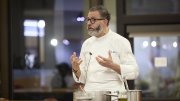Synthetic biologists can alter the genes of microbes, plants, and animals to give them new abilities, with wide-ranging applications in medicine, agriculture, and manufacturing. But one advance in the field has raised special concern: that researchers might develop the ability to create lifeforms from molecules that are mirror images of the building blocks of life. Because the release of such organisms into the environment could be lethal to most life forms, 38 prominent scientists argued in a recent commentary in Science, this line of research should be paused.
Although most experts believe that the development of such organisms is at least 10 years away, Winthrop professor of genetics George Church, a leader in the development of DNA sequencing and synthetic biology, anticipates a much shorter time frame. “It’s less than a year,” he says. “It’s already gotten to the point where somebody who is sufficiently mischievous could start with what we’ve already published and run with it.”
In biology, mirror images abound. Although the right and left claws of a lobster or the wings of a butterfly may look alike, they cannot be superimposed one over the other—they are opposites, not replicas.
Most biological molecules exhibit this same symmetry, termed “chirality.” But for unknown reasons, life on earth evolved using one side of the mirror image for specific tasks. The nucleotides that make up the building blocks of DNA and RNA, for instance, are always right-handed.
Messenger RNA then directs the assembly of left-handed amino acids into peptides, simple structures of up to 50 amino acids. This pattern holds true for all life on Earth—from the smallest microbes, throughout the plant kingdom, up to the largest megafauna.
The pharmaceutical industry has long tinkered with peptides to develop drugs, starting with the use of purified insulin a century ago. The first mirror peptides were created in the 1990s, although none are currently approved for human therapeutic use by the U.S. Food and Drug Administration. These mirror peptides are sufficiently similar to natural peptides that they can bind target cells, but their opposite-handedness confers certain advantages. One is that the body’s normal processes for breaking down peptides are stymied by mirror image peptides. The result is that the drug persists longer in the body, and patients require less frequent dosing.
Another benefit of the therapeutic use of mirror peptides: the immune system relies on very specific chiral interactions with foreign molecules, which are often sidestepped if one side of the interaction involves a mirror image. Since the immune system is responsible for certain types of drug reactions—such as rashes or hives—mirror peptides cause fewer allergic reactions.
Such research is considered safe as long as scientists avoid constructing self-replicating systems, or life, based on left-handed DNA and RNA. If someone engineered an entire mirror organism, its invisibility to the immune systems of existing life forms could lead to catastrophe.
“They would either completely or almost completely escape immune surveillance,” Jack Szostak, formerly a professor of genetics at Harvard Medical School, predicts. This absence of an immune response could enable mirror bacteria, for instance, to infect all plants and animals, with deadly consequences. And mirror bacteria pose threats to entire microbial ecosystems.
One of the main causes of bacterial cell death is infection by bacteriophages—viruses that infect these single-celled microorganisms. According to Szostak, a Nobel laureate and one of the cochairs of the group that published the Science commentary, “It’s absolutely 100 percent sure that…mirror bacteria would be resistant to all normal phages.” They would also likely escape the clutches of other bacterial predators, such as protists, that help regulate terrestrial and aquatic ecosystems. With no natural predators, mirror bacteria could spread easily in the environment.
Why would any scientist want to make a mirror organism? Now a professor in the department of chemistry at the University of Chicago, Szostak studies the origins of cellular life on Earth (see “How Life Began,” July-August 2019, p. 40), attempting to discover the chemical processes that led to the emergence of living, replicating organisms. At one time researchers proposed that mirror cells could be used to mass-produce mirror image molecules, but advances in chemical synthesis have made that unnecessary. “The other motivation is just that it’s a challenge,” Szostak says. Scientists will often choose a tricky molecule to make because it advances the technology: “You learn a lot by trying to do really hard things.”
But the authors of the Science commentary say the risks of creating mirror life outweigh any potential benefits. They propose initiating discussions with a range of stakeholders, including scientists, governments, and funding agencies, to create strategies and regulations to prevent the creation of mirror life.
The immediate need is for more research to get better experimental evidence about whether the risks are as severe as feared. “And then maybe we need some policies that won’t restrict useful, valuable research, but will at least slow down—if not totally block—anyone who is actually trying to make mirror bacteria,” Szostak explains.
According to Church, previous attempts at prohibiting research, such as limiting experimentation with recombinant DNA and President George W. Bush’s ban on federal funding for newly created human embryonic stem cell lines, backfired. In both cases, the lack of federal funding spawned investment in biotechnology startups that continued the work. “A moratorium is a semi-voluntary thing, but it’s something that only the good guys are going to sign up for,” Church says. “So, you’ve basically handed it over to the bad guys.”
Rather than hoping that a rogue scientist will not open this Pandora’s box, Church’s recommendation is to rigorously track the purchases of materials that scientists could use to develop mirror life. Twenty years ago, he published a commentary in Nature proposing a plan to monitor laboratories that purchase chemicals and biologic molecules that could serve as ingredients for producing harmful biologic agents. That sparked the formation of the International Gene Synthesis Consortium in 2009, a group of gene synthesis companies that screens DNA orders from customers to see if they match potentially dangerous pathogens.
Last year, Church published an editorial in Science that called for expanding the strategy to track all synthesized DNA sequences produced by laboratories. Records could be stored in an encrypted database and retrieved for review in the event of a novel biological threat. “You need to monitor everything that people are making, and you need to get governments to endorse this,” he says, “the way they endorse nuclear treaties.”








